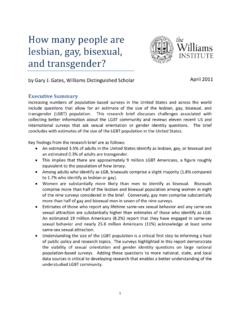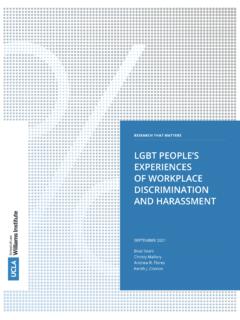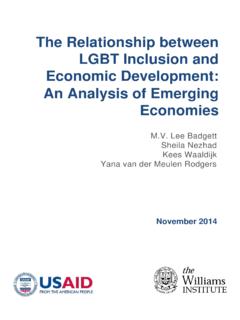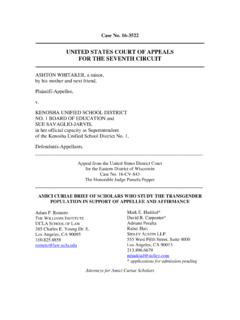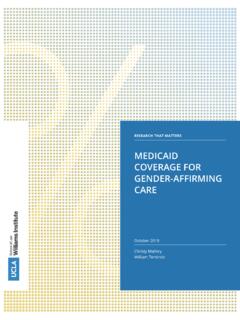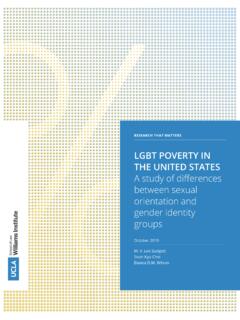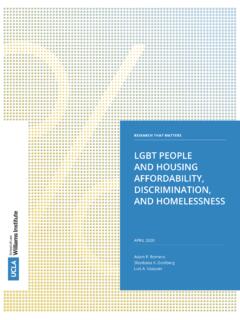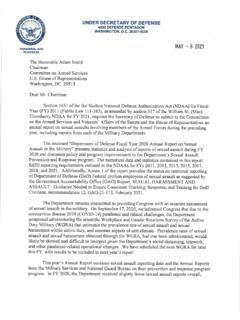Transcription of SOCIAL ACCEPTANCE OF LGBT PEOPLE IN 174 COUNTRIES
1 Andrew R. FloresOCTOBER 2019 SOCIAL ACCEPTANCE OF LGBT PEOPLE IN 174 COUNTRIES1981 TO 2017 RESEARCH THAT MATTERSS ocial ACCEPTANCE of LGBT PEOPLE in 174 COUNTRIES , 1981 to 2017 | 1 CONTENTS EXECUTIVE SUMMARY .. 2 Updates to the Global ACCEPTANCE Index .. 2 Findings: Continued Polarization .. 2 INTRODUCTION .. 4 Understanding ACCEPTANCE and Exclusion .. 4 Physical and mental health .. 5 DISCUSSION .. 8 Current Public Opinion Data and its shortcomings .. 8 METHODOLOGY .. 10 Description of data. Updates to an approach to measure opinion .. 10 FINDINGS .. 17 Overall improvement: Patterns in ACCEPTANCE .. 17 Most COUNTRIES experienced some increase in ACCEPTANCE .. 17 The most accepting COUNTRIES are becoming more 19 The least accepting COUNTRIES are becoming less accepting.
2 20 COUNTRIES near the average have stayed the same .. 21 FUTURE RESEARCH .. 23 APPENDICES .. 24 Appendix 1: Question wordings from global and regional survey data .. 24 Appendix 2: Trends in ACCEPTANCE for each country .. 30 Appendix 3: Trends in ACCEPTANCE for each country .. 38 Appendix 4: Significance test of four-year averages .. 49 AUTHORS .. 50 Acknowledgments .. 50 Suggested Citation .. 50 SOCIAL ACCEPTANCE of LGBT PEOPLE in 174 COUNTRIES , 1981 to 2017 | 2 EXECUTIVE SUMMARY This report describes updates to the LGBT (lesbian, gay, bisexual and transgender) Global ACCEPTANCE Index (GAI), which seeks to measure the relative level of ACCEPTANCE of LGBT PEOPLE and issues in each country during a specific time period. Understanding ACCEPTANCE and rejection of LGBT PEOPLE lies at the heart of understanding violence, discrimination, and a multitude of negative consequences arising from exclusion and unfair treatment.
3 sexual and gender minorities all over the world are heavily impacted by the attitudes and beliefs of those around them. Low levels of ACCEPTANCE are tied to bullying and violence, physical and mental health problems, discrimination in employment, and underrepresentation in positions of civic leadership. Additionally, exclusion can result in lower levels of workforce productivity and decreased business profits. UPDATES TO THE GLOBAL ACCEPTANCE INDEX We updated the Global ACCEPTANCE Index to measure ACCEPTANCE in 174 COUNTRIES through 2017. We initially assessed 176 geographic locations (including COUNTRIES and territories), but present results from 174 COUNTRIES in this report. ACCEPTANCE is the extent to which LGBT PEOPLE are seen in ways that are positive and inclusive, both with respect to an individual s opinions about LGBT PEOPLE and with regards to an individual s position on LGBT policy.
4 Updates included an expanded database of SOCIAL surveys measuring ACCEPTANCE of LGBT PEOPLE in a larger number of COUNTRIES (174 versus 123) and over additional years (through 2017 versus through 2014), as well as modifications to the estimation process to increase estimation accuracy. FINDINGS: CONTINUED POLARIZATION Globally, the average level of ACCEPTANCE has increased from 1981. 131 of 174 COUNTRIES experienced increases in ACCEPTANCE from 1981. 16 COUNTRIES experienced a decline. 27 COUNTRIES experienced no change. In the past decade, the range of levels of ACCEPTANCE has increased. Levels of ACCEPTANCE have become more polarized: The most accepting COUNTRIES have experienced increased levels of ACCEPTANCE ; Iceland, the Netherlands, Norway, Canada, and Spain are estimated to have the highest levels of ACCEPTANCE between 2014-2017 and all have increased in their levels of ACCEPTANCE .
5 The least accepting COUNTRIES have experienced decreased levels of ACCEPTANCE ; Ethiopia, Azerbaijan, Senegal, Tajikistan, and Somaliland are estimated to have the lowest level of ACCEPTANCE between 2014-2017 and all have decreased in their levels of ACCEPTANCE . SOCIAL ACCEPTANCE of LGBT PEOPLE in 174 COUNTRIES , 1981 to 2017 | 3 Levels of ACCEPTANCE in COUNTRIES near the global average have stayed relatively stable. Our previous report concluded that there was polarized progress in the trajectory of ACCEPTANCE of LGBT PEOPLE across the globe. The present report updates this by showing that the degree of polarization has lessened. Substantially more COUNTRIES increased on ACCEPTANCE than COUNTRIES that have decreased. While some polarization remains, the updated estimates suggest increases in LGBT ACCEPTANCE are far more common than decreases.
6 SOCIAL ACCEPTANCE of LGBT PEOPLE in 174 COUNTRIES , 1981 to 2017 | 4 INTRODUCTION UNDERSTANDING ACCEPTANCE AND EXCLUSION SOCIAL attitudes about LGBT PEOPLE can heavily influence whether LGBT PEOPLE are accepted or rejected by employers, family members, teachers, clergy, and society in Negative beliefs about LGBT PEOPLE can serve as the basis for the impulse to reject and exclude LGBT PEOPLE ,2 all too often leading to violence and discrimination against LGBT These shared beliefs are stigmas, which can be generally understood as a belief about a person based on a characteristic, or mark, of a Powerful forces in society, such as tradition, religion, law, medicine, and the media can contribute to the existence of beliefs about LGBT In some cultural settings, being LGBT carries with it the stigma that underlies a belief that the LGBT person is sick, immature, unskilled, sinful, or generally Anti-LGBT stigma can lead to the exclusion of LGBT PEOPLE from full participation in society.
7 Not only can societal stigma affect how individuals view LGBT PEOPLE , but it can also influence how PEOPLE view laws and policies relevant to LGBT LGBT PEOPLE may face rejection from others at an interpersonal level, as well as exclusion, because of stigmatizing and discriminatory laws and ACCEPTANCE , on the other hand, is the extent to which LGBT PEOPLE are seen in ways that are positive and inclusive, both with respect to an individual s opinions about LGBT PEOPLE and with regards to an individual s attitudes about LGBT rights. As defined here, ACCEPTANCE is a broad concept which encompasses SOCIAL beliefs about LGBT PEOPLE , as well as prevailing opinion about laws and policies relevant to protecting LGBT PEOPLE from violence and discrimination and promoting their equality and well-being.
8 The Global LGBT ACCEPTANCE Index (GAI) incorporates survey data about public beliefs regarding LGBT PEOPLE and policies in order to come up with a single country-level score for ACCEPTANCE . ACCEPTANCE , as 1 Gregory M. Herek, Confronting sexual Stigma and Prejudice: Theory and Practice. Journal of SOCIAL Issues 63, no. 4 (2007): 905-925. 2 Gregory M. Herek, sexual Stigma and sexual Prejudice in the United States: A Conceptual Framework, in Contemporary Perspectives on Lesbian, Gay, and Bisexual Identities, D. A. Hope (ed.), 54, p. 65-111 (New York, NY: Springer, 2009); Judit Tak cs, SOCIAL Exclusion of Young Lesbian, Gay, Bisexual, and Transgender (LGBT) PEOPLE in Europe (Brussels, BE and Amsterdam, NL: ILGA-EUROPE and IGLYO, 2006).
9 3 A. Theron, Anti-Gay Violence and Discrimination: The Need for Legislation Against Anti-Gay Hate Crimes in the Sociopolitically Changing South Africa. ACTA Criminologica 7, no. 3 (1994): 107-114. 4 Gregory M. Herek, Confronting sexual Stigma and Prejudice: Theory and Practice; Gregory M. Herek, sexual Stigma and sexual Prejudice in the United States. 5 Amy Adamczyk, Cross-National Public Opiion about Homosexuality: Examining Attitudes across the Globe (Berkeley and Los Angeles, CA: University of California Press, 2017). 6 Erving Goffman, Stigma: Notes on the Management of Spoiled Identity, (New York, NY: Penguin, 1963). 7 Gregory M. Herek. Beyond Homophobia : Thinking about sexual Prejudice and Stigma in the Twenty-First Century. Sexuality Research & SOCIAL Policy 1, no.
10 2 (2004): 6-24. 8 Mark L. Haztenbuehler, K. M. Keyes, and D. S. Hayes. State-level Politics and Psychiatric Morbidity in Lesbian, Gay, and Bisexual Populations. American Journal of Public Health 99, no. 12 (2009): 2275-2281. SOCIAL ACCEPTANCE of LGBT PEOPLE in 174 COUNTRIES , 1981 to 2017 | 5 measured in the GAI, is a country s average societal attitude toward LGBT PEOPLE that is expressed in public attitudes and beliefs about LGBT PEOPLE and rights. Understanding the Consequences of a Lack of ACCEPTANCE and Exclusion The stigma faced by LGBT PEOPLE has been linked to violence and discrimination against LGBT people9,10 and decreases in economic growth and ,12 In order to understand these linkages more deeply, development practitioners need data that is comparable across different time points and different COUNTRIES .
